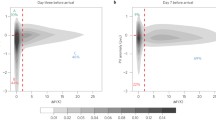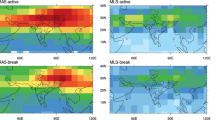Abstract
The Asian summer monsoon (ASM) anticyclone isolates upper-tropospheric air within the interior of the anticyclone from the outside. Forward trajectory simulations in previous studies have shown that much of the air within the ASM anticyclone can be trapped for up to two or three weeks, not only laterally but also vertically. Here, we investigate the locations of exit points for upper-tropospheric air trapped within the ASM anticyclone, especially the preferred tropopause-crossing locations, using a 3-dimensional trajectory model. Forward trajectory calculations show two-thirds of the air crosses the tropopause at the southern part of the anticyclone via upward diabatic transport. Furthermore, some air crosses at northern and eastern parts via isentropic shedding, but air crosses rarely through the center of the anticyclone. However, calculations also show that many stratospheric parcels within the anticyclone are traceable from the upper-tropospheric anticyclone. This implies they cannot break through the tropopause directly overhead but instead enter the stratosphere via other entry points.
Similar content being viewed by others
References
Bergman J W, Fierli F, Jensen E J, Honomichl S, Pan L L. 2013. Boundary layer sources for the Asian anticyclone: Regional contributions to a vertical conduit. J Geophys Res-Atmos, 118: 2560–2575
Bian J C, Pan L L, Paulik L, Vömel H, Chen H, Lu D. 2012. In situ water vapor and ozone measurements in Lhasa and Kunming during the Asian summer monsoon. Geophys Res Lett, 39: L19808
Bowman K P. 1993. Large-scale isentropic mixing properties of the Antarctic polar vortex from analyzed winds. J Geophys Res, 98: 23013–23027
Bowman K P, Carrie G D. 2002. The mean-meridional transport circulation of the troposphere in an idealized GCM. J Atmos Sci, 59: 1502–1514
Chen B, Xu X D, Yang S, Zhao T L. 2012. Climatological perspectives of air transport from atmospheric boundary layer to tropopause layer over Asian monsoon regions during boreal summer inferred from Lagrangian approach. Atmos Chem Phys, 12: 5827–5839
Dethof A, O’Neill A, Slingo J M, Smit H G J. 1999. A mechanism for moistening the lower stratosphere involving the Asian summer monsoon. Q J R Meteorol Soc, 125: 1079–1106
Feng S, Fu Y F, Xiao Q N. 2011. Is the tropopause higher over the Tibetan Plateau? Observational evidence from constellation observing system for meteorology, ionosphere, and climate (COSMIC) data. J Geophys Res, 116: D21121
Garny H, Randel W J. 2016. Transport pathways from the Asian monsoon anticyclone to the stratosphere. Atmos Chem Phys, 16: 2703–2718
Gettelman A, Kinnison D E, Dunkerton T J, Brasseur G P. 2004. Impact of monsoon circulations on the upper troposphere and lower stratosphere. J Geophys Res, 109: D22101
Gettelman A, Hoor P, Pan L L, Randel W J, Hegglin M I, Birner T. 2011. The extratropical upper troposphere and lower stratosphere. Rev Geophys, 49: RG3003
Homeyer C R, Pan L L, Dorsi S W, Avallone L M, Weinheimer A J, O’Brien A S, DiGangi J P, Zondlo M A, Ryerson T B, Diskin G S, Campos T L. 2014. Convective transport of water vapor into the lower stratosphere observed during double-tropopause events. J Geophys Res-Atmos, 119: 10941–10958
James R, Bonazzola M, Legras B, Surbled K, Fueglistaler S. 2008. Water vapor transport and dehydration above convective outflow during Asian monsoon. Geophys Res Lett, 35: L20810
Li D, Bian J C. 2015. Observation of a summer tropopause fold by ozonesonde at Changchun, China: Comparison with reanalysis and model simulation. Adv Atmos Sci, 32: 1354–1364
Li D, Bian J C, Fan Q J. 2015. A deep stratospheric intrusion associated with an intense cut-off low event over East Asia. Sci China Earth Sci, 58: 116–128
Li Q B, Jiang J H, Wu D L, Read W G, Livesey N J, Waters J W, Zhang Y, Wang B, Filipiak M J, Davis C P, Turquety S, Wu S, Park R J, Yantosca R M, Jacob D J. 2005. Convective outflow of South Asian pollution: A global CTM simulation compared with EOS MLS observations. Geophys Res Lett, 32: L14826
Luo J L, Tian W, Pu Z, Zhang P, Shang L, Zhang M, Hu J. 2013. Characteristics of stratosphere-troposphere exchange during the Meiyu season. J Geophys Res-Atmos, 118: 2058–2072
Orbe C, Waugh D W, Newman P A. 2015. Air-mass origin in the tropical lower stratosphere: The influence of Asian boundary layer air. Geophys Res Lett, 42: 4240–4248
Pan L L, Munchak L A. 2011. Relationship of cloud top to the tropopause and jet structure from CALIPSO data. J Geophys Res, 116: D12201
Pan L L, Honomichl S B, Kinnison D E, Abalos M, Randel W J, Bergman J W, Bian J. 2016. Transport of chemical tracers from the boundary layer to stratosphere associated with the dynamics of the Asian summer monsoon. J Geophys Res-Atmos, 121: 14159–14174
Park M, Randel W J, Kinnison D E, Garcia R R, Choi W. 2004. Seasonal variation of methane, water vapor, and nitrogen oxides near the tropopause: Satellite observations and model simulations. J Geophys Res, 109: D03302
Park M, Randel W J, Emmons L K, Bernath P F, Walker K A, Boone C D. 2008. Chemical isolation in the Asian monsoon anticyclone observed in Atmospheric Chemistry Experiment (ACE-FTS) data. Atmos Chem Phys, 8: 757–764
Randel W J, Park M. 2006. Deep convective influence on the Asian summer monsoon anticyclone and associated tracer variability observed with Atmospheric Infrared Sounder (AIRS). J Geophys Res, 111: D12314
Randel W J, Park M, Emmons L, Kinnison D, Bernath P, Walker K A, Boone C, Pumphrey H. 2010. Asian monsoon transport of pollution to the stratosphere. Science, 328: 611–613
Rosenlof K H, Tuck A F, Kelly K K, Russell Iii J M, McCormick M P. 1997. Hemispheric asymmetries in water vapor and inferences about transport in the lower stratosphere. J Geophys Res, 102: 13213–13234
Schoeberl M R, Dessler A E. 2011. Dehydration of the stratosphere. Atmos Chem Phys, 11: 8433–8446
Tao S, Zhu F. 1964. The variation of 100 mb circulation over South Asia in summer and its association with march and withdraw of West Pacific Subtropical High. Acta Meteorol Sin, 34: 385–395
Vernier J P, Thomason L W, Kar J. 2011. CALIPSO detection of an Asian tropopause aerosol layer. Geophys Res Lett, 38: L07804
Vernier J P, Fairlie T D, Natarajan M, Wienhold F G, Bian J, Martinsson B G, Crumeyrolle S, Thomason L W, Bedka K M. 2015. Increase in upper tropospheric and lower stratospheric aerosol levels and its potential connection with Asian pollution. J Geophys Res-Atmos, 120: 1608–1619
Vogel B, Günther G, Müller R, Grooß J U, Hoor P, Krämer M, Müller S, Zahn A, Riese M. 2014. Fast transport from Southeast Asia boundary layer sources to northern Europe: Rapid uplift in typhoons and eastward eddy shedding of the Asian monsoon anticyclone. Atmos Chem Phys, 14: 12745–12762
World Meteorological Organization (WMO). 1957. Meteorology–Threedimensional science: Second session of the commission for aerology. WMO Bull, 4: 134–138
Wright J S, Fu R, Fueglistaler S, Liu Y S, Zhang Y. 2011. The influence of summertime convection over Southeast Asia on water vapor in the tropical stratosphere. J Geophys Res, 116: D12302
Xie F, Li J P, Tian W S, Hu D, Zhang J, Shu J, Wang C. 2016. A quantitative estimation of the transport of surface emissions from different regions into the stratosphere. Sola, 12: 65–69
Yan R C, Bian J C. 2015. Tracing the boundary layer sources of carbon monoxide in the Asian summer monsoon anticyclone using WRF-Chem. Adv Atmos Sci, 32: 943–951
Yan R C, Bian J C, Fan Q J. 2011. The impact of the south Asia high bimodality on the chemical composition of the upper troposphere and lower stratosphere. Atmos Ocean Sci Lett, 4: 229–234
Zhang Q, Wu G X, Qian Y F. 2002. The bimodality of the 100 hPa south Asia high and its relationship to the climate anomaly over east Asia in summer. J Meteorol Soc Jpn, 80: 733–744
Acknowledgements
This work was supported by the National Natural Science Foundation of China (Grant Nos. 91337214 & 41675040).
Author information
Authors and Affiliations
Corresponding author
Rights and permissions
About this article
Cite this article
Fan, Q., Bian, J. & Pan, L.L. Stratospheric entry point for upper-tropospheric air within the Asian summer monsoon anticyclone. Sci. China Earth Sci. 60, 1685–1693 (2017). https://doi.org/10.1007/s11430-016-9073-5
Received:
Accepted:
Published:
Issue Date:
DOI: https://doi.org/10.1007/s11430-016-9073-5




